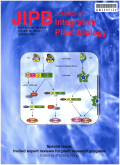- 钛学术文献服务平台 \
- 学术期刊 \
- 基础科学期刊 \
- 生物科学期刊 \
- 植物学报(英文版)期刊 \
An update on the function and regulation of methylerythritol phosphate and mevalonate pathways and their evolutionary dynamics
An update on the function and regulation of methylerythritol phosphate and mevalonate pathways and their evolutionary dynamics
基本信息来源于合作网站,原文需代理用户跳转至来源网站获取
摘要:
Isoprenoids are among the largest and most chemically diverse classes of organic compounds in nature and are involved in the processes of photosynthesis, respiration, growth, development, and plant responses to stress. The basic building block units for isoprenoid synthesis—isopentenyl diphosphate and its isomer dimethylallyl diphosphate—are generated by the mevalonate (MVA) and methylerythritol phosphate (MEP) path-ways. Here, we summarize recent advances on the roles of the MEP and MVA pathways in plant growth, development and stress responses, and attempt to define the underlying gene networks that orchestrate the MEP and MVA pathways in re-sponse to developmental or environmental cues. Through phylogenomic analysis, we also provide a new perspective on the evolution of the plant iso-prenoid pathway. We conclude that the presence of the MVA pathway in plants may be associated with the transition from aquatic to subaerial and terres-trial environments, as lineages for its core compo-nents are absent in green algae. The emergence of the MVA pathway has acted as a key evolutionary event in plants that facilitated land colonization and subsequent embryo development, as well as adaptation to new and varied environments.

推荐文章
The oxygen isotopic composition of phosphate as an effective tracer for phosphate sources in Hongfen
Phosphate source
δ18OP
Eutrophication
Hongfeng Lake
Soil organic carbon dynamics study bias deduced from isotopic fractionation in corn plant
Bias of SOC dynamics study
Isotopic fractionation in corn
Isotope mass balance equation
Bias range
Zircon saturation model in silicate melts: a review and update
Zircon
Zircon saturation
Model
Silicate melt
Mafic to silicic melts
Peraluminous to peralkaline compositions
Igneous rocks
Thermometer
护眼进化论 眼霜也要Update
进化论
眼霜
包装设计
APP
科技
内容分析
关键词云
关键词热度
相关文献总数
(/次)
(/年)
引文网络
引文网络
二级参考文献 (0)
共引文献 (0)
参考文献 (0)
节点文献
引证文献 (0)
同被引文献 (0)
二级引证文献 (0)
2021(0)
- 参考文献(0)
- 二级参考文献(0)
- 引证文献(0)
- 二级引证文献(0)
引文网络交叉学科
相关学者/机构
期刊影响力
植物学报(英文版)
主办单位:
中国植物学会
出版周期:
月刊
ISSN:
1672-9072
CN:
11-5067/Q
开本:
大16开
出版地:
北京香山南辛村20号中科院植物所内
邮发代号:
2-500
创刊时间:
1952
语种:
eng
出版文献量(篇)
3621
总下载数(次)
1
期刊文献
相关文献
推荐文献
- 期刊分类
- 期刊(年)
- 期刊(期)
- 期刊推荐
力学
化学
地球物理学
地质学
基础科学综合
大学学报
天文学
天文学、地球科学
数学
气象学
海洋学
物理学
生物学
生物科学
自然地理学和测绘学
自然科学总论
自然科学理论与方法
资源科学
非线性科学与系统科学
植物学报(英文版)2022
植物学报(英文版)2021
植物学报(英文版)2020
植物学报(英文版)2019
植物学报(英文版)2018
植物学报(英文版)2017
植物学报(英文版)2016
植物学报(英文版)2015
植物学报(英文版)2014
植物学报(英文版)2013
植物学报(英文版)2012
植物学报(英文版)2011
植物学报(英文版)2010
植物学报(英文版)2009
植物学报(英文版)2008
植物学报(英文版)2007
植物学报(英文版)2006
植物学报(英文版)2005
植物学报(英文版)2004
植物学报(英文版)2003
植物学报(英文版)2002
植物学报(英文版)2001
植物学报(英文版)2000
植物学报(英文版)1999
植物学报(英文版)1998
植物学报(英文版)2021年第9期
植物学报(英文版)2021年第8期
植物学报(英文版)2021年第7期
植物学报(英文版)2021年第6期
植物学报(英文版)2021年第5期
植物学报(英文版)2021年第4期
植物学报(英文版)2021年第3期
植物学报(英文版)2021年第2期
植物学报(英文版)2021年第11期
植物学报(英文版)2021年第10期
植物学报(英文版)2021年第1期

 免费查重
免费查重










